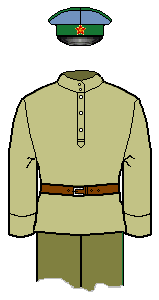
Kursanty
The kursanty were the Red equivalent of military cadets (the word literally means someone taking a course, kurs). The Red Army was in desperate need of trained commanders and thousands of men were rushed through hastily set up training schools in order to provide them (11,500 in 1919 alone)
For short periods, especially in a crisis, they might be mobilised to fight at the front lines. When they did so, they were among the best troops in the Red Army.
Such times include:
- An Independent Combined Kursant Brigade was fielded on the Petrograd front in mid-1919.
- A Combined Kursant Brigade from Moscow and Petrograd, under KomBrig P.N. Yezhov in Northern Taurida in July 1920
- In October 1920, the 2nd Petrograd Kursant Brigade, KomBrig Martynov, was sent to the Wrangel front, then to fight Makhno.
They were also mobilised when troops of proven loyalty were required after the war against the main White armies was over, despite there being plenty of other units available. Such times include the large numbers from various schools for the 1921 assault on Kronstadt and units sent against Makhno.
Whenever possible, kursanty were brigaded together, with their own cavalry and artillery. The Red Army tried to avoid mixing them with troops of other origins.
Uniforms
Their uniform was standard Red Army, but their headgear was often a sidecap (piltoka), such as shown in the Osprey C1 and AST VI.1, with or without the piping.

A kursanty parade, wearing side caps.
While there were some shortages, this being the RCW, they do seem to be generally quite a lot better uniformed than most Red Army. They seem to be some of the first units to get the new "1919" uniforms.
Sources
Siberia Miniatures has a thread with lots of photos. (link currently dead)
Tver Cavalry School

The Wikiwand page on the Tver Cavalry School gives some interesting information.
Their non-dress uniform was a cap with a dark green band and a blue crown, dark green edging. Standard tunic and breeches, cavalry boots and a cavalry overcoat with dark green piping.
This would add a difference to a kursant unit without having to find difficult figures. Commanders could even wear the blue breeches of the dress uniform.
The parade uniform was ex-Tsarist stock in blue and green, with a lancer shako with white plume. Shown as Plate E3 in the Osprey.
Action in the RCW
From 20 May to 23 August 1919, the entire course (179 cadets, 16 commanders, 9 admin and 38 Red Army men) were sent to the Petrograd front. They were part of the Composite Cavalry Regiment (later cavalry division) of the Independent Composite Kursant Brigade.
From 25 August to 16 September 1919, 292 cadets, 17 commanders, 8 admin and 36 Red Army men were sent of the Tula fortified area, to guard the town against Mamontov.
On 16 September to 10 October 1919, a squadron of approximately 60 cadets, 4 commanders, 14 admin and Red Army soldiers, were placed in the Composite Ukrainian Cossack Brigade and sent to Tambov province to protect it from Mamontov and Shkuro.
On 15 July 1920 to 12 November 1920, a cavalry platoon, 28 cadets, 2 commanders and 2 Red Army soldiers, was sent to the Southern Front as part of the 1st Moscow Kursant Brigade.
On 10 August 1920, 190 cadets, 15 commanders, 54 admin and Red Army men were sent to the Southern Front as part of the 2nd Composite Cavalry Regiment of the 2nd Moscow Kursant Brigade.
From 11 August 2 1920 to 12 November 1920, 60 cadets, 2 commanders and 2 Red Army men, were added to the 1st Moscow Kursant Brigade on the Southern Front.
From 3 to 25 March 1921, 182 cadets, 8 commanders and 18 admin and Red Army men, were sent to Petrograd to suppress the Kronstadt mutiny.